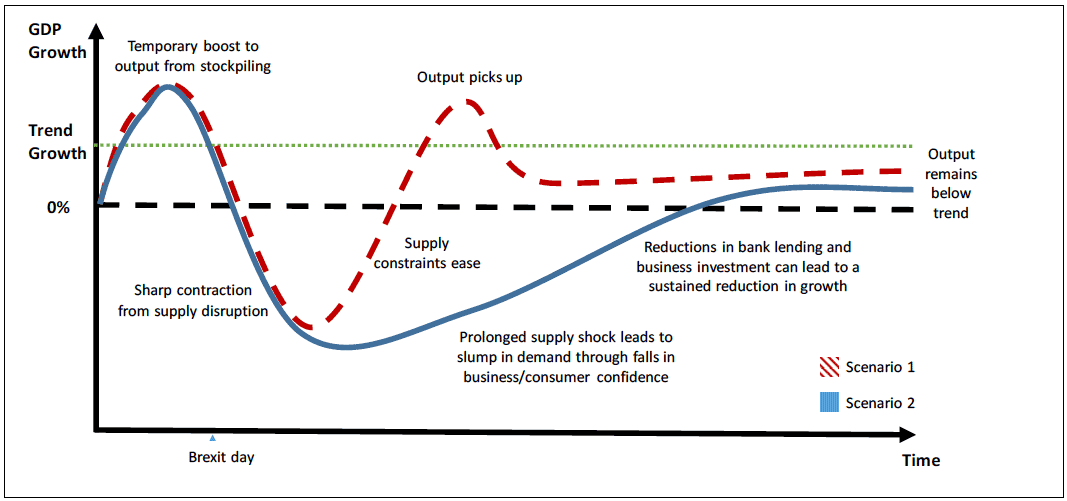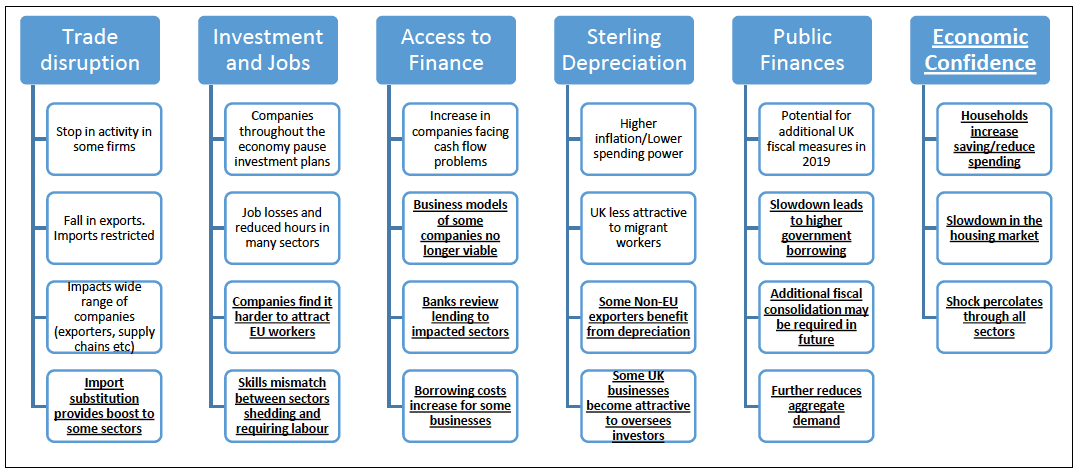No-deal Brexit: economic implications for Scotland
Illustration of the potential impact that a no-deal Brexit - leaving the EU on the 29th March 2019 without a transition period or agreement on any future trade deal and wider economic relationship - could have on the Scottish economy over the next 12-24 months.
Section 2 - Scenario Analysis and Transmission Mechanisms
There are a range of potential outcomes which fall under the heading 'No Deal Brexit'. The following analysis provides an indicative range of impacts based on two illustrative scenarios, as described below. These have been chosen to demonstrate the channels through which a No Deal Brexit could impact the Scottish economy. No probability is prescribed to the likelihood of either scenario occurring and a range of alternative scenarios are possible.
Scenario 1 (Supply Shock)
In the first scenario - a short, sharp, supply disruption - it is assumed that a No Deal Brexit with no transition agreement leads to an immediate economic shock from the second quarter of 2019. This shock is assumed to be primarily on the supply side, causing major disruption to the movement of goods and services. This shock leads to a loss of output in some sectors combined with higher prices. It is assumed to be triggered through various channels including:
- Disruption to supply chains leading to lower production, restricted supplies, and shortages of perishable commodities.
- Scottish exports to and imports from the EU being significantly restricted.
- Scotland's trade with countries with which the EU currently has Free Trade Deals being restricted.
- Reduction in turnover leaving some companies cash-constrained.
- Companies delaying investment and recruitment plans, reducing hours for those on flexible contracts and reducing overall staff numbers.
- Depreciation of Sterling resulting in higher inflation and subsequently reducing households and businesses spending power.
It is assumed that these impacts last for a number of months at which point some form of agreement is reached between the UK Government and the EU which enables the supply constraints to be resolved. The shock is then anticipated to gradually unwind before the economy stabilises at a new, lower 'normal' level of activity.
Scenario 2 (Supply and Demand Shock)
In the second scenario - a significant supply and demand shock lasting for an extended period - it is assumed that the supply shock lasts for longer which in turn leads to a collapse in demand, through a sustained fall in consumer and business confidence. This shock not only leads to a loss in output but leads to lower demand. In addition to the above channels, such an outcome is assumed to result in:
- Further falls in consumer spending, and slowdown in the housing market, as households deleverage - increasing savings or reducing debt levels.
- Companies in the wider economy, including those not directly exposed to Brexit, delaying or cancelling investment.
- Companies reducing the number of people they employ and the number of hours available to staff.
- Some companies being unable to access finance, and the cost of finance increasing, as banks re-evaluate their risk appetite.
- Reduced freedom of movement with the EU restricting companies' ability to attract workers and deploy workers across international borders.
The potential, illustrative, path of Scottish GDP under these scenarios is summarised in the chart below.
Figure 7 - Illustrated Impact of No Deal Brexit on Scottish GDP

Source: Scottish Government
There are a range of channels through which each scenario could impact on the wider economy. These are summarised in the diagram below. The headings in bold represent the additional transmission channels under the second scenario.
Figure 8 - Transmission Channels for a No Deal Brexit

Contact
Email: OCEABusiness@gov.scot
There is a problem
Thanks for your feedback